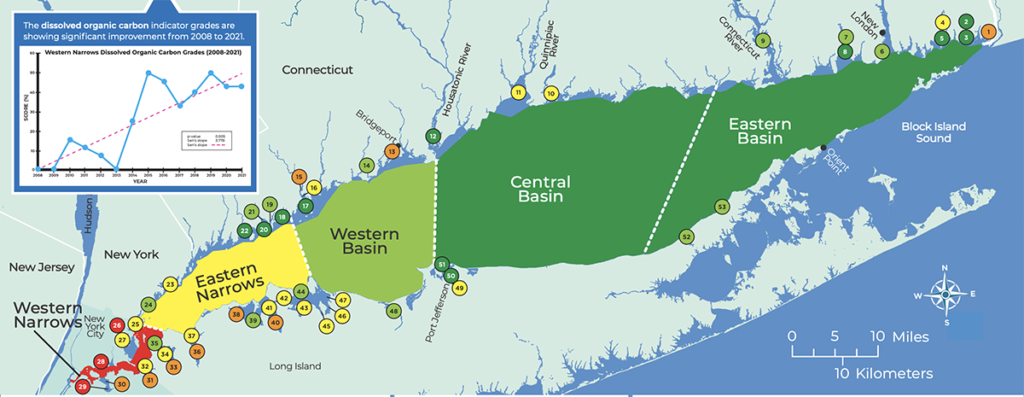Report: Eastern Long Island Sound healthy despite concerns over rising water temperatures

The Long Island Sound waters off the North Fork remain in good health, according to a recent report.
Save the Sound’s 2022 Long Island Sound report card released on Nov. 17 reveals “excellent grades” for the eastern basin of the Sound, which extends from Riverhead past Orient Point. The eastern basin received an A+ grade.
The regional nonprofit organization based in Mamaroneck, N.Y. and New Haven, Conn. has been compiling 14 years of water testing results on the Sound’s waters and four years of testing more than 50 bays and bay segments in the region, according to a press release by Save the Sound.
According to the report card, the eastern basin’s water quality has been stable over the past 14 years, never dropping below an A. The consistent good grades are “driven by strong tidal exchange with the Atlantic Ocean and lower population density, relative to areas further west,” according to the press release. The central basin, which extends from Port Jefferson to Riverhead, also received an A.
Save the Sound and its science advisors grade water quality indicators by using scientifically derived scales that were developed with a technical advisory committee of scientists and water managers from agencies around the Sound, according to the report. They use some indicators from both the Sound and the bays, while they also use others which are “unique to the deeper Sound or the shallower bays,” the report card stated.
Despite consistent good health, however, the report found that some trends towards improving open water quality have stalled in several portions of the Sound and poor grades in the bays have persisted. Of the 53 bay segments monitored, more than half (57%) received disheartening grades of C, D, or F, the press release stated.
The two North Fork bays tested, Mattituck Creek and Goldsmith Inlet in Southold, both scored a B- on the report.

Click here to read the full report issued by Save the Sound
The bays’ persistent low grades can be attributed to their high susceptibility “to pollutants from their neighboring communities,” according to the report. Although local efforts have helped produce some improvements, the sweeping low grades reveal the impact that pollution has on coastal waters. The report also reinforces prior evidence that the quality of nearby open water on the Sound doesn’t always determine the quality of water in neighboring bays.
“We’re finding evidence that investment in clean water infrastructure leads to measurable benefits for Long Island Sound,” said David Ansel, regional director of water protection for Save the Sound. “It’s also clear that there is much more to be done, particularly in stressed bays throughout the length of the Sound, as well as in the western sound.”
The impacts of climate change also threaten to roll back gains made in previous years unless additional measures are undertaken, warned senior science advisors for the 2022 Long Island Sound Report Card Jaime Vaudrey, PhD, and Jason Krumholz.
They cited a peer reviewed 2021 study from researchers at the University of Connecticut, which noted that the temperature in the western Long Island Sound is increasing by as much as 0.8 degrees Celsius or near 1.4 degrees Fahrenheit.
This rise in water temperature increases the risk for hypoxia or low levels of oxygen within the water. “The warmer the water, the less oxygen it is able to hold,” the report card states.
“The good news contained in this report is that tactics designed to improve water quality in Long Island Sound have been effective. It takes reliable long-term data to identify what is working and where, and just as important, what areas need more help,” Mr. Krumholz said. “While progress has been made, continued efforts are necessary to meet our ultimate goals.”
Data on the water quality in the bays of Long Island Sound were compiled by 24 partner organizations working with identical water testing procedures in the Unified Water Study, which is funded by the U.S. Environmental Protection Agency’s Long Island Sound Study, according to the press release. They track levels of dissolved oxygen, chlorophyll a, water clarity, seaweeds and oxygen saturation to determine the annual scores.








